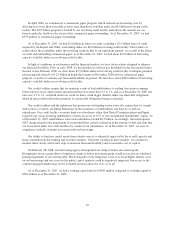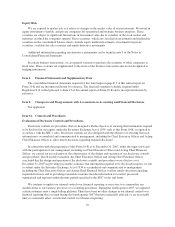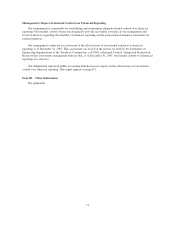Sprint - Nextel 2007 Annual Report Download - page 67
Download and view the complete annual report
Please find page 67 of the 2007 Sprint - Nextel annual report below. You can navigate through the pages in the report by either clicking on the pages listed below, or by using the keyword search tool below to find specific information within the annual report.In April 2006, we commenced a commercial paper program, which reduced our borrowing costs by
allowing us to issue short-term debt at lower rates than those available under our $6.0 billion revolving credit
facility. The $2.0 billion program is backed by our revolving credit facility and reduces the amount we can
borrow under the facility to the extent of the commercial paper outstanding. As of December 31, 2007, we had
$379 million of commercial paper outstanding.
As of December 31, 2007, we had $2.6 billion in letters of credit, including a $2.5 billion letter of credit
required by the Report and Order, outstanding under our $6.0 billion revolving credit facility. These letters of
credit reduce the availability under the revolving credit facility by an equivalent amount. As a result of the letters
of credit and outstanding commercial paper, as of December 31, 2007, we had about $3.0 billion of borrowing
capacity available under our revolving credit facility.
In light of conditions in our business and the financial markets, we have taken actions designed to enhance
our financial flexibility. First, in early 2008, we decided that we will not pay dividends for the foreseeable future.
Second, in late February 2008, we drew down $2.5 billion under our revolving credit facility to mitigate potential
refinancing risk related to $1.25 billion in bonds that mature in November 2008 and our commercial paper
program, as well as to enhance our financial flexibility in general. We now have about $500 million of borrowing
capacity available under our revolving credit facility.
Our credit facilities require that we maintain a ratio of total indebtedness to trailing four quarter earnings
before interest, taxes, depreciation and amortization of no more than 3.5 to 1.0, and as of December 31, 2007, the
ratio was 2.5 to 1.0. A default under our credit facilities could trigger defaults under our other debt obligations,
which in turn could result in the maturities of certain debt obligations being accelerated.
Our credit facilities and the indentures that govern our outstanding senior notes also require that we comply
with various covenants, including limitations on the incurrence of indebtedness and liens by us and our
subsidiaries. Our credit facility covenants limit our subsidiaries (other than Nextel Communications and Sprint
Capital Corp.) from incurring indebtedness or liens in excess of 15% of our consolidated shareholders’ equity. As
of December 31, 2007, indebtedness from such subsidiaries totaled $0.5 billion. Accordingly, the fourth quarter
2007 charge related to the impairment of our goodwill has caused a reduction in the amount of debt and liens that
can be incurred under our credit facilities by certain of our subsidiaries. As of December 31, 2007, we were in
compliance with all covenants associated with our borrowings.
Our ability to fund our capital needs from outside sources is ultimately impacted by the overall capacity and
terms available from the banking and securities markets. Given the volatility in these markets, we continue to
monitor them closely and to take steps to maintain financial flexibility and a reasonable cost of capital.
On February 28, 2008, one debt rating agency downgraded our rating to below investment grade.
Downgrades of our current short or long-term ratings to below investment grade would not accelerate scheduled
principal payments of our existing debt. The downgrade of our rating may cause us to incur higher interest costs
on our borrowings and our access to the public capital markets could be negatively impacted. Our access to the
commercial paper market may not be available on terms attractive to us, or at all.
As of December 31, 2007, we had a working capital deficit of $443 million compared to working capital of
$562 million as of December 31, 2006.
65
























